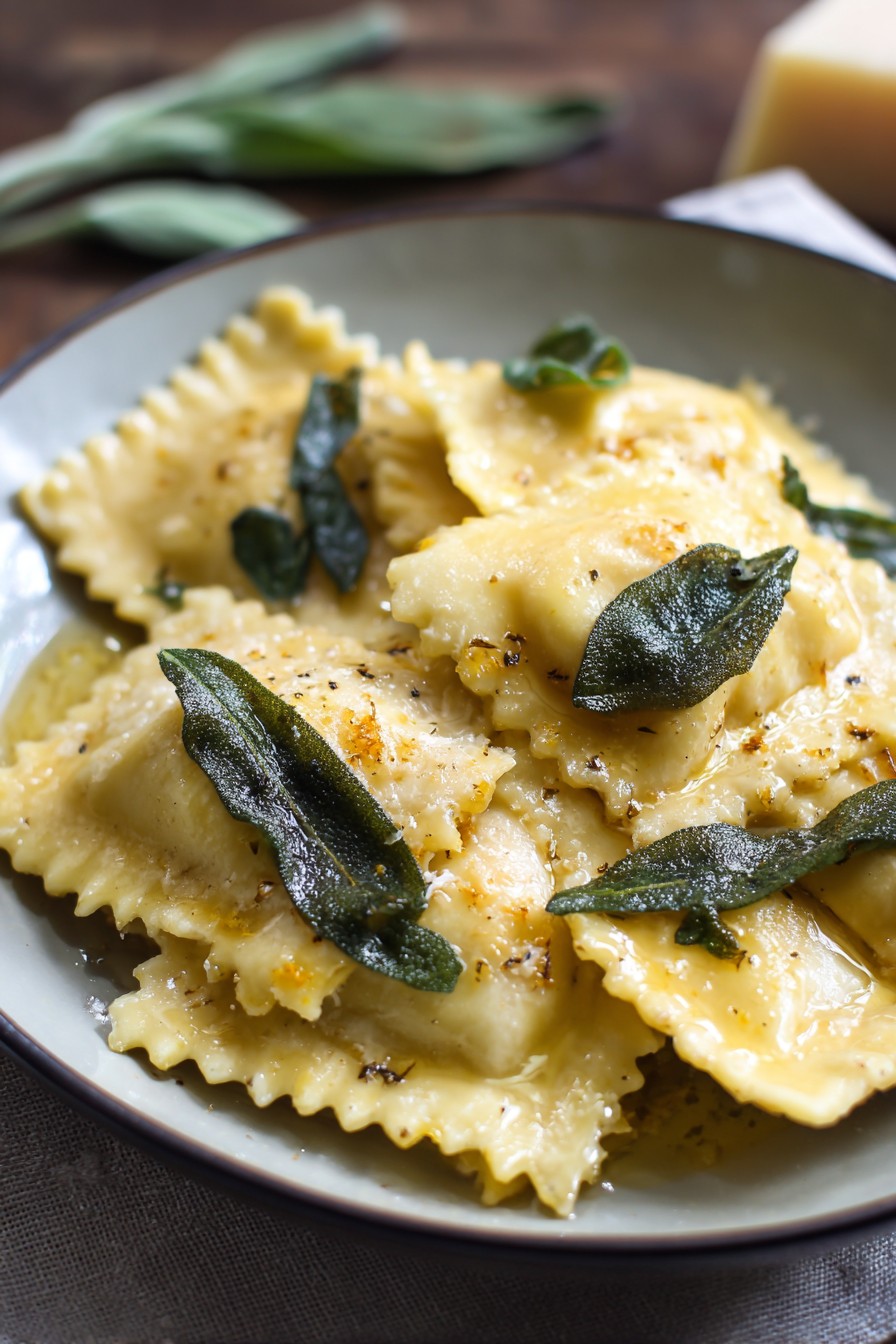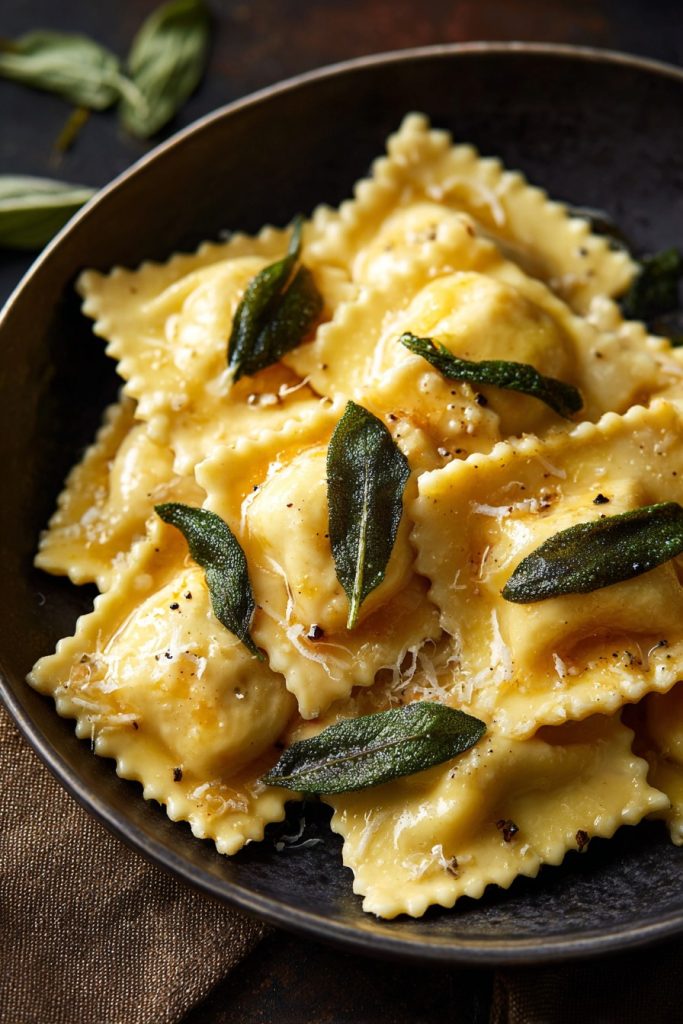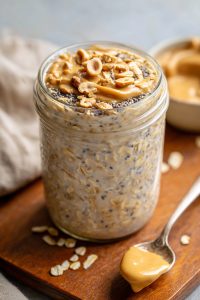Absolutely nothing compares to the soul-satisfying experience of biting into homemade ravioli that YOU created with your own two hands. This isn’t just pasta—it’s little pillows of pure joy that will transport you straight to Italian grandmother heaven with every single, glorious bite that bursts with flavor and love in your mouth.
Why This Recipe Works
- The silky-smooth pasta dough achieves perfect elasticity and tenderness through precise kneading and resting, creating that signature delicate-yet-sturdy texture that holds your filling without tearing or becoming gummy during cooking.
- Our rich three-cheese filling combines creamy ricotta, sharp Parmesan, and nutty fontina for maximum flavor complexity that melts into pure bliss inside each delicate pasta pocket, creating an unforgettable taste experience.
- The simple brown butter sage sauce requires just minutes to prepare but elevates the entire dish to restaurant-quality status with its nutty, aromatic depth that clings perfectly to every ravioli surface.
- Proper sealing techniques ensure zero filling leakage during cooking, guaranteeing that every single ravioli delivers its full flavor payload directly to your taste buds without any disappointing breaks or spills.
- Resting the dough allows gluten to relax completely, resulting in tender pasta that cooks evenly and maintains perfect al dente texture rather than becoming tough or chewy from overworked flour proteins.
Ingredients
- 2 cups all-purpose flour, plus extra for dusting
- 3 large eggs, at room temperature
- 1 tablespoon olive oil
- 1 teaspoon salt
- 1 cup whole milk ricotta cheese, drained
- 1/2 cup grated Parmesan cheese
- 1/2 cup shredded fontina cheese
- 1 egg yolk
- 1/4 teaspoon freshly grated nutmeg
- 1/4 teaspoon black pepper
- 1/2 cup unsalted butter
- 10-12 fresh sage leaves
- Salt and pepper to taste
Equipment Needed
- Large mixing bowl
- Pasta roller or rolling pin
- Ravioli cutter or pizza cutter
- Pastry brush
- Large pot
- Skillet
- Measuring cups and spoons
- Kitchen scale (optional but recommended)
Instructions

Create Your Perfect Pasta Dough Foundation
Place 2 cups of all-purpose flour directly onto your clean countertop, creating a well in the center that resembles a flour volcano ready for its magical transformation. Crack 3 large room-temperature eggs into this flour crater along with 1 tablespoon of glorious olive oil and 1 teaspoon of salt—watch as the golden yolks glisten with promise! Using a fork, gently beat the eggs while gradually incorporating flour from the inner walls, creating a thick, sticky paste that slowly absorbs more flour until a shaggy dough forms. Now comes the therapeutic part: knead this beautiful mess for 8-10 solid minutes until it transforms into a smooth, elastic ball that springs back when gently pressed—this gluten development is absolutely CRITICAL for that perfect pasta texture. Wrap your dough masterpiece tightly in plastic wrap and let it rest at room temperature for exactly 30 minutes, allowing the gluten to relax completely so your ravioli won’t shrink or become tough during rolling.
Craft Your Irresistible Three-Cheese Filling
While your pasta dough undergoes its essential relaxation period, combine 1 cup of beautifully drained whole milk ricotta cheese with 1/2 cup each of grated Parmesan and shredded fontina in a medium bowl—this triple-threat cheese combination creates flavor harmony that will make your taste buds sing with joy! Add 1 egg yolk (which acts as your magical binding agent), 1/4 teaspoon of freshly grated nutmeg (trust me, this warm spice elevates everything), and 1/4 teaspoon of black pepper, then mix until perfectly combined but not overworked. Taste your creation and adjust seasoning if needed—remember, the cheeses already bring saltiness, so add cautiously. Cover this heavenly filling mixture and refrigerate for 15-20 minutes to firm up slightly, making it infinitely easier to work with when filling your delicate pasta pockets without any messy leakage issues.
Roll and Fill Your Ravioli Masterpieces
Divide your rested dough into four equal portions, keeping three covered while working with one—this prevents drying out, which is the enemy of perfect pasta! Using a pasta roller or rolling pin, roll your first portion to the second-thinnest setting (number 6 on most machines) or until you can almost see your hand through it—this delicate thickness creates that signature tender bite while still holding the filling securely. Lay your beautiful sheet of pasta on a lightly floured surface and place teaspoon-sized mounds of your chilled cheese filling in two rows, spacing them about 1 1/2 inches apart. Lightly brush water around each filling mound with a pastry brush—this creates the glue that seals your ravioli pockets perfectly. Carefully place another pasta sheet over top, gently pressing around each filling mound to remove air pockets, then use a ravioli cutter or pizza cutter to create individual squares, pressing firmly to ensure complete sealing.
Cook Your Ravioli to Perfection
Bring a large pot of generously salted water to a rolling boil—it should taste like the sea, which seasons your pasta from within as it cooks! Gently lower your ravioli creations into the boiling water in batches to avoid overcrowding, which causes sticking and uneven cooking. Cook for precisely 3-4 minutes—they’re done when they float to the surface and look slightly translucent around the edges, with a tender-yet-firm bite when tested. PRO TIP: Reserve 1/2 cup of that magical pasta water before draining—the starchy liquid will help your sauce cling beautifully to every ravioli surface later. Use a slotted spoon to transfer cooked ravioli directly to your serving dish rather than dumping them in a colander, which can damage their delicate structure and cause filling leakage.
Create Your Brown Butter Sage Sauce
While your ravioli undergo their boiling transformation, melt 1/2 cup of unsalted butter in a large skillet over medium heat, swirling occasionally until it foams, then subsides, and golden brown specks begin to form at the bottom—this nutty, aromatic stage is pure culinary magic! Add 10-12 fresh sage leaves and cook for just 30-45 seconds until they become crisp and fragrant—be careful not to burn the butter, which happens quickly past this point and creates bitter flavors. Immediately remove from heat and stir in that reserved pasta water, which will sizzle and create an emulsified sauce that clings perfectly to every ravioli surface. Gently toss your cooked ravioli in this glorious brown butter sage sauce until each piece is beautifully coated, then serve immediately while hot and glorious.
Tips and Tricks
For absolutely foolproof ravioli that never break during cooking, ensure your filling isn’t too wet by draining ricotta in a fine-mesh strainer for at least 30 minutes before mixing—excess moisture is the number one cause of leaking pasta pockets and watery fillings that compromise texture. When rolling your pasta dough, work quickly but methodically, keeping unused portions covered with a damp cloth to prevent drying, which creates cracks and sealing issues that can ruin your beautiful creations. For picture-perfect ravioli every single time, use an egg wash (1 egg beaten with 1 tablespoon water) rather than plain water around the edges—this creates a stronger seal that withstands boiling without any separation or filling loss during the cooking process. If you don’t have a pasta machine, roll your dough as thin as humanly possible using a heavy rolling pin, frequently rotating and dusting with flour to prevent sticking—you should be able to vaguely see your hand through the dough when held to light for that perfect delicate texture. For freezing perfection, arrange uncooked ravioli in a single layer on a parchment-lined baking sheet, freeze until solid (about 2 hours), then transfer to freezer bags—they’ll keep for 3 months and can go straight from freezer to boiling water, adding just 1-2 minutes to cooking time. When testing doneness, always sacrifice one ravioli by cutting it open to check if the filling is hot and the pasta is cooked through—floating is a good indicator but not absolute proof of perfect doneness throughout. For extra flavor dimension, add a tablespoon of freshly chopped herbs like parsley or basil to your cheese filling, or incorporate finely chopped sautéed mushrooms or spinach for vegetable-forward variations that maintain the same magical texture.
Recipe Variations
- For a luxurious meat-filled version that will satisfy even the heartiest appetites, replace the cheese filling with a mixture of ground pork, veal, and Parmesan cheese seasoned with garlic, lemon zest, and fresh parsley—brown the meats first, then cool completely before filling your pasta pockets for maximum flavor development and food safety.
- Create stunning seasonal butternut squash ravioli by roasting cubed squash until tender, then mashing with ricotta, amaretti cookie crumbs, and sage for an autumnal masterpiece that pairs beautifully with the same brown butter sauce or a creamy walnut sauce for ultimate comfort food vibes.
- For seafood lovers seeking coastal elegance, combine lump crab meat with lemon zest, mascarpone cheese, and chives for delicate ravioli that scream sophistication—serve with a light white wine butter sauce rather than the heavier brown butter to let the delicate seafood flavors shine through beautifully.
- Transform this into vibrant spinach and ricotta ravioli by wilting fresh spinach, squeezing out ALL moisture, then combining with your cheese mixture and a pinch of red pepper flakes for subtle heat—the green flecks create visual appeal while adding nutritional depth to your pasta masterpiece.
- For dairy-free dietary needs, use vegan ricotta alternative and nutritional yeast instead of Parmesan, with olive oil replacing the egg yolk as binder—the texture remains surprisingly similar while accommodating restrictions without sacrificing that signature ravioli experience everyone craves.
Frequently Asked Questions
Can I make the ravioli dough ahead of time?
Absolutely YES—in fact, making your pasta dough 24 hours in advance actually improves both texture and flavor development! Wrap your dough ball tightly in plastic wrap and refrigerate overnight, then remove from refrigerator 30-60 minutes before rolling to come to room temperature, which makes it much easier to work with without cracking. The extended resting allows gluten strands to fully hydrate and relax, resulting in more tender pasta that rolls out beautifully and cooks to perfect al dente texture every single time without any toughness or chewiness issues.
Why did my ravioli break open during cooking?
This heartbreaking tragedy usually occurs for three main reasons: insufficient sealing around the edges, overfilling the pasta pockets, or rolling the dough too thick. Ensure you press firmly around each filling mound with your fingers before cutting, leaving at least 1/2-inch border, and use just one teaspoon of filling per ravioli—they should look modest rather than bursting. Also, roll your dough thin enough that you can vaguely see through it when held to light, as thick dough expands dramatically during cooking and puts pressure on the seams.
Can I freeze homemade ravioli successfully?
Freezing homemade ravioli is not just possible—it’s highly recommended for busy weeknights! Arrange uncooked ravioli in a single layer on parchment-lined baking sheets, freeze until rock solid (about 2 hours), then transfer to freezer bags for up to 3 months. Cook directly from frozen by adding them to boiling water and extending cooking time by 1-2 minutes—they’ll taste nearly identical to fresh and provide instant gourmet meals whenever the ravioli craving strikes without warning.
What’s the best way to reheat leftover cooked ravioli?
For perfectly revived ravioli that doesn’t become mushy or rubbery, gently reheat them in a skillet with a tablespoon of butter or olive oil over medium-low heat rather than microwaving, which creates uneven heating and texture degradation. Add a splash of water or broth to create steam that gently warms them through without further cooking, tossing occasionally until heated evenly—this method preserves that delicate pasta texture and prevents the filling from becoming dry or separated.
Summary
This homemade ravioli recipe delivers restaurant-quality pasta magic right in your kitchen with silky dough, luxurious three-cheese filling, and aromatic brown butter sage sauce that creates unforgettable culinary moments worth every minute of effort.



